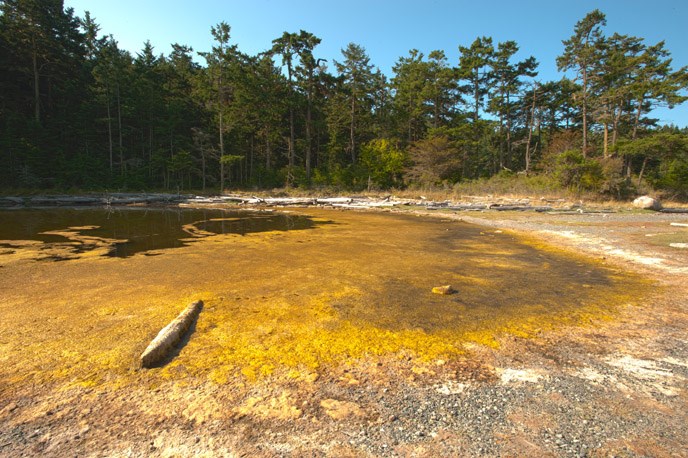
Gary Tarleton San Juan Island is surrounded by a vast expanse of saltwater, however the island has a very limited amount of fresh surface water. Thus, groundwater is essential for a healthy island ecosystem. Groundwater manifests itself in seeps and springs. Subsurface groundwater inflow may replenish wetland areas or add freshwater to tidal lagoons. Wells tap into groundwater supplies, known as aquifers. With the final melting of the glaciers, all fractures, cracks and loose glacial outwash material underlying the region were supercharged with fresh water. Today, groundwater recharge is slow, relying on local annual precipitation ranging from a scant 17 inches to 32 inches. From one-half to two-thirds of the annual precipitation returns to the atmosphere through evapotranspiration (evaporation and transpiration) as water is cycled back into the atmosphere from surface water, soils, and plant surfaces. Most of the remaining one-third to one-half of precipitation runs off in small creeks, down rocky slopes, or over impermeable or saturated soils to reach surface bodies of water. Only a very small percentage of annual rainfall infiltrates to recharge the groundwater aquifers. Aquifer recharge on San Juan Island occurs almost exclusively from October through April when precipitation is high and evapotranspiration is low. Recharge is site speciific with geology, soil type, topography and vegetation influencing the amount of water infiltration. Wetlands increase infiltration by supplying a water storage site. Wetlands also filter water as it slowly seeps into the aquifer If groundwater is withdrawn faster then it is replenished, the results can be disastrous for ecosystem health. The various habitats of San Juan Island National Historical Park depend on a stable water table as well as adequate annual rainfall. An adequate supply of water is also needed for the administration of the site (water for staff, visitor and volunteer use). When rainfall decreases or precipitation patterns depart from the norm, and island water consumption rates fail to mirror these changes, water shortages--for humans and wildlife populations--are the result. To illustrate this point, in the summer of 1994 the island experienced an extended drought and the well supplying drinking water to American Camp was drawn down to a critical level. To allow it to recharge, the well had to be shut down for two months at the height of the visitor season. By far, saltwater intrusion is the primary source of groundwater quality degradation in this region, and high chloride levels are used as an indicator. As with most island aquifers, fresh water occurs as a lens floating atop the more dense saltwater. If the freshwater is pumped faster then it is recharged, saltwater moves in to take its place. Once the aquifer is contaminated by seawater, recovery as a freshwater source is a slow process. Acting to prevent saltwater intrusion is of utmost concern for park managers, particularly at American Camp, in order to maintain an adequate freshwater supply. Unfortunately, some island wells have already been contaminated by saltwater intrusion. In 1970 the well at American Camp tested within the acceptable range for chloride. But from 1981 to the present, the well water has exceeded the drinking water standards for chloride, which may indicate the influence of saltwater intrusion Fluctuations in salinity of Jakle’s Lagoon may indicate subsurface freshwater inflow into the lagoon. Since there are no active or intermittent surface channels flowing into the lagoon, any freshwater input into the lagoon is dependent upon direct precipitation, intermittent runoff, or groundwater discharge. It is possible that groundwater is entering Jakle’s, Third and Old Town lagoons via aquifer interception. If significant amounts of groundwater are regularly flowing into the lagoons, then pumping in the vicinity could possibly impact that flow and the ecological integrity of the lagoons. Maintaining adequate, pure and fresh groundwater is critical for all life on San Juan Island. Increasing groundwater withdrawals could potentially lower the water table of aquifers; increase the possibility for saltwater intrusion; alter freshwater inputs to springs, seeps, ponds and wetlands; alter salinity regimes in tidal lagoons, and alter existing habitats. |
Last updated: March 16, 2015
